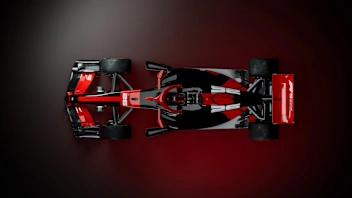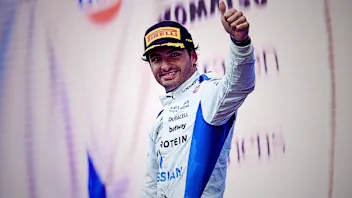Jolyon Palmer’s Analysis: How Lando Norris managed a car with hydraulic issues

Lando Norris put in a storming weekend in France, qualifying fifth on only his eighth Grand Prix weekend, and his race was equally impressive. A loss of hydraulic pressure meant his McLaren effectively began shutting down on Lap 33 of 53 – and yet he was still able to finish ninth…
The hydraulics on a Formula 1 car control so many different aspects, including the brakes, differential, power steering, gear shifting, the clutch and the DRS.
Usually hydraulic issues are very sudden onset and rule a driver out of the race immediately. In fact, two of my own Grands Prix were ended on the formation lap – before the race had even begun - as I had hydraulics issues that stopped the car in its tracks.
So in that sense, Norris was lucky that this issue was very slow onset – but at the same time, how he dealt with it was magnificent.
Problem #1
Firstly, Norris was told not to use the DRS. This was a simple one. He wasn’t within a second of team mate Carlos Sainz at the time and in a position to attack, so he couldn’t use it anyway - except for lapping other cars, and here it never became a big issue.
Problem #2
The next things Norris had to deal with were much more critical. Worsened differential performance and heavier steering were the subsequent issues he was warned to watch for over the radio, to which Norris replied he could feel the steering getting heavier immediately.
Power steering is crucial in Formula 1. It’s not how you might imagine power steering in your road car, where the steering weight is super light and you can turn the wheel without knowing it.
In Formula 1, such is the high speed and level of downforce on these cars, you really would struggle to drive the car without power steering – the steering weight would be simply too heavy in the fast corners.
So for Norris, the fact that his power steering was reducing would have made his life much harder, particularly at a circuit like Paul Ricard where there’s a lot of long, fast, sweeping corners, like Turn 11.
Heavier steering not only requires more effort to steer the car and fundamentally drive, but it also makes it more difficult to react to the minutiae of correcting slides which are happening often.
Problem #3
The differential. The ‘diff’ (which essentially allows the rear wheels to rotate at different speeds) is a critical balancing tool for Formula 1 drivers. You can lock the diff in certain corners which will effectively give you better traction, but more stability and understeer too. At the same time, if you are struggling with front tyres or understeer, drivers can unlock the diff, which will get more rotation into the car, allowing it to turn more easily, at risk of more oversteer and worse traction.
For Norris, he was getting more oversteer, which could be seen from the onboard shots as well, and worse traction at the same time, as he effectively had a more open diff due to his hydraulics issue.
Now this would be tough enough for any driver to deal with on its own. Traction is crucial to keeping the driver behind at bay as you need to get good exits from the corners...
Problem #4
Not only this though. Norris had worse shifting performance as well, so he would be losing time with each gearshift as well, which would hamper straight-line performance.
This can even be heard on the onboard as well on the final lap. It’s a very small difference compared to those around him, but it does cost him time on the straights.
Problem #5
Finally, the brakes would be affected as the hydraulic system controls brake-by-wire, which is the braking systems these current hybrid Formula 1 cars use.
Norris would have had a changing brake balance as the hydraulic issue worsened, and that would have made it risky for him to brake on the absolute limit, for fear of locking and losing a lot of time.
All of these issues made Norris’ job increasingly tricky. Firstly he clearly lost pace in the car, as you would expect in this situation, and that’s why in the closing stages he dropped away from Sainz and right into the grasp of Renault's Daniel Ricciardo.
But once into the Aussie’s clutches, he was then relatively a sitting duck because of all these issues. An erratic car balance, a lack of traction and straight-line speed and also an inconsistency with the brakes.
To be honest, none of these issues appeared to be horrendous on their own, because clearly Norris still had relative performance, but combined they would have been making his job extremely difficult, and it was inevitable he would be passed.
But between him and his McLaren team, they did a great job at managing and communicating the problems clearly. Despite all of this going on, Norris stayed calm, kept his pace up, never made a significant error... and it earned him a much-deserved two points.
READ MORE: ‘Best weekend of the season’ gives McLaren momentum, says Seidl
Next Up
Related Articles
.webp) End Of Year Reports 2025Alpine’s best and worst moments from 2025
End Of Year Reports 2025Alpine’s best and worst moments from 2025 10 ways to get your Formula 1 fix during the winter break
10 ways to get your Formula 1 fix during the winter break Everything you need to know about F1's new rules for 2026
Everything you need to know about F1's new rules for 2026 WATCH: F1 Animated returns for a look back at 2025
WATCH: F1 Animated returns for a look back at 2025 Lindblad's car number confirmed for rookie season
Lindblad's car number confirmed for rookie season ExclusiveWhy Sainz feels ‘vindicated’ after his first Williams year
ExclusiveWhy Sainz feels ‘vindicated’ after his first Williams year